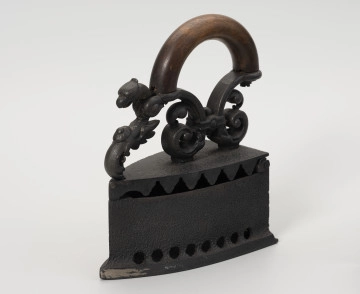
Iron stand
1890 — 1910
National Museum in Szczecin
Part of the collection: Household
Before the widespread use of electric irons, a commonly used type was the slug iron. The slug (known as dusza in Polish) was usually an iron bar that, after being heated in a fire, was inserted into the iron through an opening in its rear part. A flap or sliding cover prevented the slug from falling out during ironing. Inside the iron, there were ridges on which the slug rested. It couldn't lie directly on the bottom of the device, as that would cause the iron to overheat, potentially scorching the fabric being ironed. Due to the gradual cooling of the slug, it was practical to have at least two slugs ready—while one was in use, the other could be heating up. One major advantage of slug irons over coal irons was that their use did not carry the risk of soiling the laundry. The ethnographic collection of the National Museum in Szczecin features a brass slug iron from the second half of the 19th century. It has a soleplate shaped like an elongated triangle, which forms a single piece with the rounded body, whose front part is quite sharply pointed. Irons with this body shape are called "ox tongues" due to their resemblance to the shape of a bovine tongue and have been known since the late 18th century. They were most popular from the second half of the 19th century until the 1920s. The iron presented here is decorated with an engraved zoomorphic motif depicting bears in a forest. Such decorations on irons were rare. Because of the rich ornamentation, it can be assumed that this iron was intended for wealthier customers. Nowadays, old irons often serve as decorative elements or collectible items. Agnieszka Słowińska
Author / creator
Object type
iron
Technique
casting, montaż ręczny, engraving, turning (machining)
Material
mosiądź, iron, wood
Origin / acquisition method
legal transfer
Creation time / dating
Creation / finding place
Owner
The National Museum in Szczecin
Identification number
Location / status

fabryka nieznana
1890 — 1910
National Museum in Szczecin

fabryka nieznana
1851 — 1900
National Museum in Szczecin

fabryka nieznana
1901 — 1939
National Museum in Szczecin
DISCOVER this TOPIC
Museum of King Jan III's Palace at Wilanów
DISCOVER this PATH
Educational path
0/500

We use cookies to make it easier for you to use our website and for statistical purposes. You can manage cookies by changing the settings of your web browser. More information in the Privacy Policy.
We use cookies to make it easier for you to use our website and for statistical purposes. You can manage cookies by changing the settings of your web browser. More information in the Privacy Policy.
Manage cookies:
This type of cookies is necessary for the website to function. You can change your browser settings to block them, but then the website will not work properly.
WYMAGANE
They are used to measure user engagement and generate statistics about the website to better understand how it is used. If you block this type of cookies, we will not be able to collect information about the use of the website and we will not be able to monitor its performance.